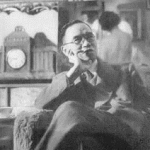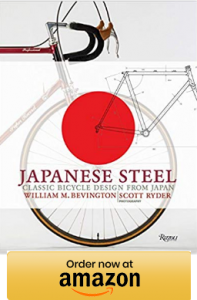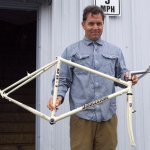 Bridgestone as a corporation is gigantic, but it has always concerned itself with products related to transportation. Its founder, Shōjirō Ishibashi (the name translates as “stone bridge”) began making tabi, traditional
Bridgestone as a corporation is gigantic, but it has always concerned itself with products related to transportation. Its founder, Shōjirō Ishibashi (the name translates as “stone bridge”) began making tabi, traditional
Japanese sandals, in 1925 and moved to tire manufacture in 1931.

The company is now best known for its namesake tires and also
owns the U.S. tire manufacturer, Firestone. Along the way, Bridgestone built motorcycles, cars and in 1945 began building bicycles as well. Not the sort of bikes stateside riders imagine but Japanese-style city bikes, with step-
through frames, baskets and generator lights. Apparently, the
company made sporting bikes as well. Information about its early history is surprisingly hard to find given its size today.
BRIDGSTONE BUILDS PLANT IN AGO
The Bridgestone Cycle Co Ltd. originated in 1949. It offered bicycles under its own brand and under the Anchor brand. At one time, Bridgestone marketed bicycles under the name Kabuki Around 1960 the company built its Ageo Plant in Ago, Saitama Prefecture. The Company began manufacturing motorbikes named Bridgestone Champion. After incorporating the small engine division of Prince Motor Co., Ltd. (an associated company). Bridgestone Bicycle was renamed Bridgestone Cycle Industry Co., Ltd.
COMPANY RECEIVES AWARDS
In 1966 Bridgestone Cycle Industry received the industry’s first Good Design Award for “Super Light” and “Jet Bambi” a kids tricycle. In 1968 the Company received the industry’s first Okochi Memorial Production Award, in recognition of its innovative bicycle frame manufacturing method (based on the die cast method) as an excellent research result leading to reduced costs and improved productivity.
GRANT PETERSON JOINS BRIDGESTONE
Bridgestone had developed a high level of expertise in sport bike design by the early 1980s. This was accelerated when Grant Petersen, now of Rivendell Bicycle Works, joined the company as Bridgestone USA’s marketing boss. Petersen learned much of his design philosophy from contacts with Bridgestone designers in Japan. Bridgestone USA’s glory days are usually referred to as, “the Grant Petersen years.” Nonetheless, his success was rooted deeply in the company’s quality-obsessed origins.

Grant developed a reputation for resisting popular trends in the bicycle industry and instead followed his own personal philosophy of building dependable and comfortable bicycles. Peterson applied this approach to Rivendell after Bridgestone stopped marketing bicycles in the U.S

It was largely on Petersen’s watch that those Bridgestone products so sought by collectors today were designed and manufactured, having now evolved into a bonafide bicycling paradigm.
BIKES THAT SOLD IN AMERICA
The bicycles that were selling the most were the racing-style road and mountain bikes. Adults in America feel compelled to justify bicycle riding by implying that they are engaging in competition, or at least preparing to, or pretending to prepare to.
It was this market that Bridgestone hired Petersen to address, and he did it in a way that confounded many and delighted a perceptive and lucky few in America’s bicycle community. It also established a legacy that has continued to enrich both bicycling and the public culture of our country.  Ishibashi’s motto for the company was, “For the welfare and happiness of all mankind.” While it may be suspect that building monster tires for SUVs, as Bridgestone now does, is
Ishibashi’s motto for the company was, “For the welfare and happiness of all mankind.” While it may be suspect that building monster tires for SUVs, as Bridgestone now does, is
in perfect harmony with that sentiment, there is no denying the bicycle is a near perfect vehicle for actualizing Ishibashi’s hopes.
Bridgestone USA made a strategic move by appointing Petersen as marketing director. Consequently, his vision aligned perfectly with the company’s goals. Furthermore, during a notable 1992 California Bicyclist interview, Petersen emphasized sustainable transportation. “The best use of a bicycle is commuting,” he declared, highlighting urban mobility solutions.
Additionally, Grant supported this eco-friendly transportation initiative. Therefore, reducing automobile traffic became a core mission for Bridgestone’s bicycle division. Meanwhile, the company faced the challenge of marketing bikes to status-conscious American consumers. However, they needed to accomplish this objective with restricted marketing resources. The focus on bicycle commuting complemented broader sustainability goals.
GRANT SETS OUT TO SELL AMERICANS ON BICYCLES
In 1984, Bridgestone USA welcomed Grant Petersen to their team. Subsequently, he launched a mission to promote practical cycling solutions. Initially, he found the Japanese design philosophy aligned with his vision. Moreover, his connection with Hiroshi Iimura of Jitensha Studio proved influential. Through this Berkeley-based collaboration, Petersen deepened his understanding of versatile bicycle design.
Additionally, his approach to bicycle engineering emphasized multipurpose functionality. Consequently, Bridgestone bikes gained recognition for their durability and performance. Furthermore, these bicycles excelled in adaptability across various terrain.
Therefore, riders could confidently tackle different road conditions without significant modifications. The innovative design approach reflected Bridgestone’s commitment to practical engineering excellence.
Bridgestone Uses The French Touch
At Bridgestone, Petersen blended Japanese engineering with European design influences. Therefore, his component selections often favored French manufacturers. Furthermore, Bridgestone bikes prioritized durability and reliability above all else.
Subsequently, this philosophy carried into his Rivendell venture, where he developed “rough stuff” bicycles. Moreover, Bridgestone’s approach championed versatile road bikes with narrow tires. Additionally, Petersen enhanced models with practical features like fenders and racks.
Consequently, these Bridgestone bicycles performed well in various weather conditions. Meanwhile, the wider tire options improved overall comfort. The comprehensive design strategy reflected Bridgestone’s commitment to practical cycling solutions.
BRIDGESTONE’S CAME EQUIPPED
Bridgestone bicycles under Petersen’s leadership delivered exceptional durability and performance. Furthermore, these Bridgestone models challenged conventional cycling trends. Subsequently, their unique design philosophy confused traditional cyclists.
Additionally, Bridgestone revolutionized mountain bike development. Therefore, their innovative approach included drop handlebars on premium models. Moreover, Bridgestone’s “Dirt Drops” handlebars set new standards for off-road cycling.
Meanwhile, Bridgestone’s road bikes achieved significant racing success. Consequently, the Bridgestone RB-1 and RB-2 models became highly sought after. Furthermore, vintage Bridgestone RB-1 bikes maintain impressive resale values. Additionally, the Bridgestone RB-T transformed from an unconventional release into a preferred cyclocross option. Therefore, these bikes demonstrate Bridgestone’s lasting impact on cycling culture.

THE QUIRKIEST BRIDGESTONE EVER PRODUCED
Bridgestone’s XO series represented Petersen’s innovative vision. Subsequently, this unique Bridgestone model challenged industry standards. Furthermore, Bridgestone incorporated French cycling influences into the design. Additionally, the XO featured versatile 26-inch wheels for multiple applications. Therefore, Bridgestone engineered these frames for exceptional adaptability.
Moreover, XO bikes accommodated various tire options. Consequently, riders could switch between slick and knobby tires. Additionally, Bridgestone included practical features for bicycle touring. Meanwhile, the XO pioneered triple crankset configurations. Furthermore, Bridgestone distinguished the series with distinctive moustache handlebars. The innovative design approach showcased the company’s commitment to versatile cycling solutions.
Grant Peterson Symbolizes Bridgestone
The moustache bar symbolizes Grant Petersen to many people in the bike biz, and Grant Petersen symbolizes Bridgestone, so it’s worth taking a look at their relationship. The bar is a Petersen design, inspired by the handlebars made popular during the first bike boom at the end of the 19th century.
To quote Petersen on the current Rivendell website: “[It’s] a variation of a shape that has been around for more than a century – longer than drop bars. The details of this one bend evolved during five prototypes and thousands of miles of testing and refinement during my commute to work in 1990-91. The first prototype was bent by a plumber out of copper tubing.”
Petersen’s ambition was not just selling bikes, not even
well-made, affordable, practical and sporty bikes – which he did. It was rather creating a community centered on the bicycle but going beyond the bicycle. Subsequently, he structured Bridgestone catalogs to resonate this belief. As a result, articles included topics like, the history of bicycling, the means and manners of the rider and the ride, things that in some way reflected the spirit of the bicycle.
Bridgestone Diversified
Bridgestone continues manufacturing professional-grade track racing frames in Japan. Furthermore, Bridgestone adheres to strict Nihon Jitensha Shinkokai standards. Additionally, they produces diverse bicycle models for Japanese consumers. Meanwhile, the company markets premium road bikes under the Anchor brand.
Subsequently, the company expanded its innovation through collaboration. Therefore, the Moulton Bicycle emerged from partnership with Dr. Alex Moulton. Moreover, Bridgestone developed the Picnica folding bicycle. The comprehensive product range demonstrates Bridgestone’s ongoing commitment to cycling excellence.
CLICK ON ITEM FOR MORE INFORMATION

We earn from qualified Amazon purchases with NO cost to you. In fact, ANY item that you need or were going to purchased anyway through the above links, helps support this site. Thank you for your support!
